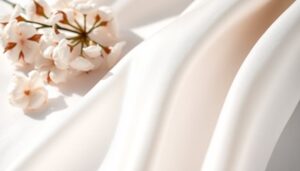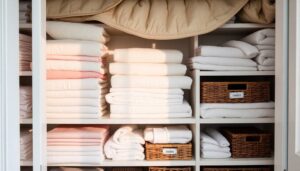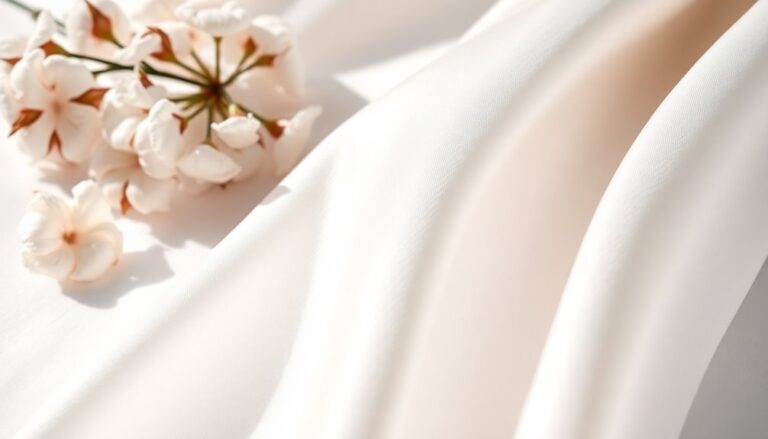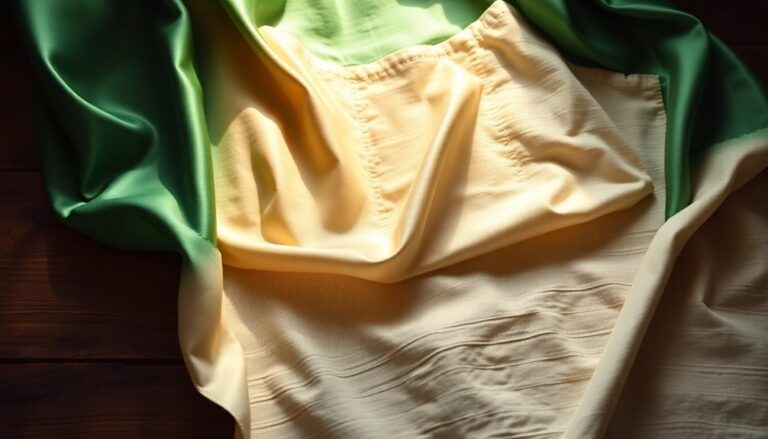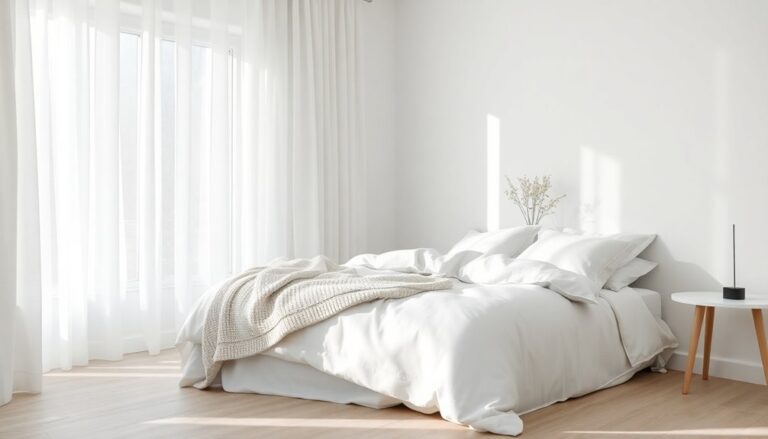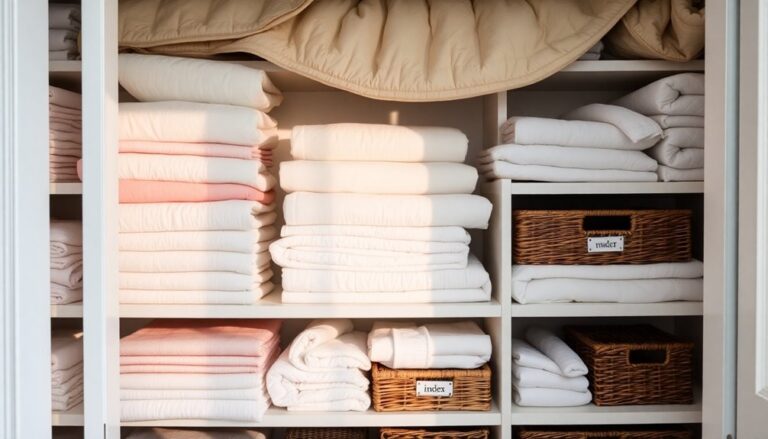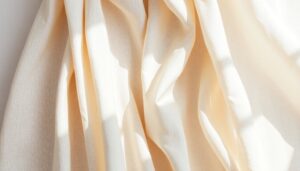When comparing linen and synthetic fabrics, each has its own strengths. Linen's breathable, moisture-wicking properties make it ideal for warm climates and stylish, while its natural durability guarantees longevity. Conversely, synthetic fabrics like polyester and nylon offer resilience and ease of maintenance, but may trap heat. Linen's biodegradable nature is likewise an advantage over petroleum-based synthetics. Those interested in a more in-depth analysis will discover further insights into their differences and suitability for various needs.
Article Highlights
- Linen excels in breathability, making it ideal for warm climates and effective at regulating body temperature.
- Synthetic fabrics offer durability and resilience, often with greater resistance to wrinkles and easier maintenance.
- Linen is biodegradable and environmentally friendly, while synthetics contribute to pollution and microplastic issues.
- Although linen may have a higher initial cost, its longevity provides better long-term value compared to quick-wearing synthetics.
- For comfort, linen outperforms most synthetics, as it effectively wicks moisture and promotes ventilation during wear.
Understanding Linen: Characteristics and Benefits

Linen, a timeless fabric known for its elegance and durability, offers a unique blend of characteristics that set it apart from other materials. The linen texture is distinctively crisp and slightly coarse, providing a sophisticated look whilst remaining comfortable against the skin. This fabric's breathability is another significant advantage, making it ideal for warm weather. Air flows easily through the fibers, allowing for excellent moisture-wicking properties. As a result, linen garments help keep wearers cool and dry, even on the hottest days. Furthermore, linen's natural strength guarantees longevity, making it a practical choice for those seeking both style and durability. With these qualities, linen remains a popular choice for fashion and home textiles alike.
Exploring Synthetic Fabrics: Types and Features
Synthetic fabrics come in various types, each with its own unique features. Polyester, nylon, and spandex are just a few examples that offer durability and stretch. Comprehending these materials can help consumers make informed choices for their clothing and home textiles.
Types of Synthetic Fabrics
Fabrics made from synthetic materials offer a wide range of options, each with unique characteristics and applications. One popular synthetic fabric is nylon, known for its durability, elasticity, and resistance to mildew and abrasion. These nylon characteristics make it ideal for activewear and outdoor gear. Another widely used synthetic fabric is polyester, which has excellent moisture-wicking properties and retains its shape well. Polyester uses are extensive, ranging from clothing to home furnishings and industrial applications. Other synthetic fabrics include acrylic, which mimics wool, and spandex, often blended with other materials for added stretch. Each type of synthetic fabric serves a specific purpose, catering to various needs and preferences in the textile market.
Key Features Overview
In the domain of choosing textiles, grasping the key features of various materials can greatly influence one's decision. Synthetic fabrics, such as polyester, nylon, and spandex, offer unique advantages that set them apart from natural fibers like linen. These materials typically boast durability, resistance to wrinkles, and easy maintenance. In a fabric comparison, one might notice significant texture differences; synthetic fabrics often have a smoother feel, whereas linen presents a more textured surface. Additionally, synthetic options tend to wick moisture away, making them ideal for active wear. Comprehending these key features helps consumers select the best fabric for their needs, ensuring comfort and functionality without compromising on style.
Breathability and Comfort: Linen Vs Synthetic

Though many people appreciate the durability of synthetic materials, they often find themselves longing for the breathability and comfort that linen provides. Linen's natural fibers allow for excellent airflow, making it a top choice for warm weather. Its breathability factors contribute to a cooling effect, helping to regulate body temperature and reduce moisture buildup. Conversely, synthetic fabrics can trap heat and sweat, leading to discomfort during hot days. While some may argue that modern synthetics offer improved comfort levels, they still can't match linen's innate ability to wick away moisture and promote ventilation. Ultimately, for those prioritizing breathability and comfort, linen remains the superior option, especially in climates where temperature regulation is crucial for overall well-being.
Durability and Maintenance: Which Fabric Lasts Longer?
Although breathability plays a significant role in fabric choice, durability and maintenance are equally important factors to take into account. Linen, meanwhile, can be strong but may be prone to wrinkles and requires gentle washing to guarantee fabric longevity. It's often best to air dry and iron when slightly damp to maintain its integrity. Conversely, synthetic fabrics like polyester are engineered for resilience and are often more resistant to wear and tear. They typically require less maintenance, as they can withstand machine washing and drying without significant damage. For those seeking longevity, it's vital to follow specific maintenance tips for each fabric type to improve their lifespan and preserve their quality over time.
Environmental Impact: Natural Vs Man-Made

When considering the environmental impact of fabrics, it's essential to recognize how natural and synthetic materials differ in their lifecycle. Linen, a natural fiber, often aligns with sustainability practices, as it's biodegradable and requires fewer chemicals during production. Conversely, synthetic fabrics like polyester are derived from petroleum, leading to significant pollution concerns. The manufacturing process for synthetics emits harmful toxins and contributes to microplastic pollution in oceans. Although some synthetic fabrics are designed to be recycled, the overall impact still raises questions about their long-term sustainability. In an era where eco-consciousness is indispensable, the choice between linen and synthetic fabrics isn't just about comfort or durability; it's also about making responsible decisions that consider the planet's health.
Cost Comparison: Is Linen Worth the Investment?
Is linen truly worth the investment compared to synthetic fabrics? When conducting a cost analysis, it becomes clear that linen often carries a higher upfront price. Nevertheless, its durability and longevity can provide significant investment value over time. Unlike synthetic fabrics, which may wear out or fade quickly, linen can withstand years of use, making it a cost-effective choice in the long run. Furthermore, linen's breathability and comfort make it a preferred option for many, enhancing its worth beyond mere price tags. Whereas some might balk at the initial cost, the benefits of linen—such as reduced replacement frequency and timeless appeal—often justify the expense, ultimately making it a smart investment for quality-conscious consumers.
Choosing the Right Fabric for Your Lifestyle
Investing in linen can have its rewards, but choosing the right fabric finally depends on an individual’s lifestyle and preferences. When considering fabric selection tips, it is crucial to evaluate daily activities and personal comfort. For those who lead active lifestyles, synthetic fabrics may offer durability and ease of maintenance, whereas linen’s breathability makes it ideal for warm climates and leisurely outings. Furthermore, individuals with sensitive skin might prefer linen for its hypoallergenic properties. In the end, lifestyle compatibility should guide this choice. Those who prioritize eco-friendliness will appreciate linen’s natural qualities, whereas busy individuals may lean in the direction of the convenience of synthetic options. Comprehending these factors can help anyone make a well-informed decision that improves their everyday experience. Understanding the differences in linen vs other fabrics allows individuals to make choices that best suit their needs and values. While linen offers breathability and sustainability, other fabrics may provide stretch, moisture resistance, or wrinkle resistance, catering to different lifestyles. By weighing these factors, one can select a fabric that enhances both comfort and practicality in daily life.
Frequently Asked Questions
Can Linen Fabrics Be Machine Washed Safely?
Linen fabrics can be machine washed safely, but it's important to follow some linen care guidelines. When washing, use a gentle cycle with cold water to avoid shrinking. It's best to place linen items in a mesh laundry bag and avoid bleach. After washing, air drying is recommended to maintain the fabric's integrity. By following these washing tips, one can keep their linen looking fresh and lively for years to come.
Do Synthetic Fabrics Offer UV Protection?
When considering whether synthetic fabrics offer UV protection, it is essential to acknowledge that many do provide significant UV resistance. This resistance often improves fabric durability, making these materials suitable for outdoor activities. Although not all synthetic fabrics are created equal, those particularly designed for sun exposure can effectively block harmful rays. Consequently, individuals seeking reliable UV protection should look for options labeled with high UV ratings, ensuring both comfort and safety in the sun.
What Is the Best Way to Store Linen?
Storing soft, sumptuous linen requires attention and care. To guarantee ideal linen care, one should embrace proper linen storage techniques. First, it's wise to wash and thoroughly dry the linen before folding. Next, she suggests using breathable cotton bags or boxes to prevent dust accumulation. Furthermore, keeping the fabric away from direct sunlight helps maintain its color and integrity. By following these practices, linen can remain fresh and fabulous for future use.
Are Synthetic Fabrics Recyclable?
When considering whether synthetic fabrics are recyclable, it is essential to recognize that not all synthetic materials can be recycled effectively. Although some companies are working on synthetic recycling methods, many fabrics contribute negatively to the environmental impact because of their non-biodegradable nature. Nonetheless, advancements in technology are leading to better recycling processes, allowing for some synthetic textiles to be repurposed. Comprehending these options can help consumers make more eco-friendly choices.
How Does Humidity Affect Linen and Synthetic Fabrics?
Humidity markedly impacts both linen and synthetic fabrics. Linen's natural fibers excel in moisture absorption, allowing it to wick away sweat and remain breathable, making it comfortable in humid conditions. Conversely, synthetic fabrics typically struggle with breathability, often trapping heat and moisture, leading to discomfort. Although they're designed to resist moisture, they don't match linen's ability to manage humidity effectively. Comprehending these differences helps individuals choose the right fabric for their needs.

